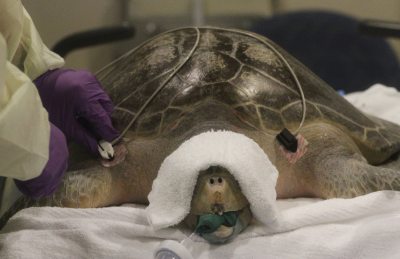SEATTLE — The patient tag on the board outside the hyperbaric chamber says “T. Turtle,” who is having buoyancy problems.
He likely has bubbles in his gastrointestinal tract. They prevent him from diving, making him more vulnerable as prey.
He’s Tucker, the rescued olive ridley sea turtle being rehabbed at the Seattle Aquarium.
This is one lucky turtle. He was found washed ashore at Cannon Beach, Ore., unable to swim, close to death. The aquarium staff took him in Dec. 14, helped him to breathe around the clock for a week, pumping air into his lungs by hand until he could do so on his own.
On Monday, Tucker became the first nonhuman patient to receive treatment at Virginia Mason’s Center for Hyperbaric Medicine.
Dr. James Holm and his team worked with Dr. Lesanna Lahner from the aquarium as Tucker was sedated and wheeled on a gurney into the chamber.
It’s a $6.1 million facility capable of holding up to 16 patients in two compartments. The doors to the cylinder look as if they’ve come from a submarine, and portholes are all around the 46-foot-long cylinder.
Most people treated there have the diver’s condition known as decompression sickness, or the bends. Or they have carbon-monoxide poisoning or need help with injuries such as nonhealing diabetic wounds and tissue damaged by radiation during cancer treatments.
Virginia Mason donated its services; turtles don’t have insurance.
Holm, who has been diving for four decades and on occasion swims with turtles, knew what was possible in assisting the aquarium and Tucker with appropriate treatment.
The treatment ended, he’s eating on his own, but it will take a CT scan later this week to be sure the air pockets have decreased.
It’s not clear when he can be returned to the ocean, but he’s getting healthier.



